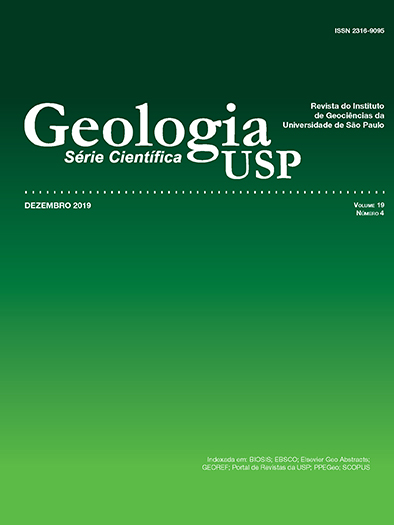Stratigraphic mapping using high-resolution seismic exploration at the site of the future Salvador-Itaparica Bridge, Bahia, Brazil
DOI:
https://doi.org/10.11606/issn.2316-9095.v19-150500Keywords:
Todos os Santos Bay, Shallow high-resolution seismic, Bays, SPT drill holesAbstract
The Quaternary marine sedimentary sequences have been extensively studied using shallow-reflection marine seismic, which is based on the propagation of seismic waves in order to investigate subsurface geological features. Seismic data in association with SPT drill holes may produce information about the lithology, cohesion, depth, thickness, and lateral continuity of the layers. Thus, it has great use for planning and performing engineering works in submerged regions, such as bridges. This work carried out a stratigraphic mapping to identify the top of the rocky substrate and the thickness of the recent sedimentary cover in the region of Todos os Santos Bay (BTS), in which a bridge connecting the city of Salvador to the island of Itaparica will be built. High-resolution seismic lines were obtained using Boomer and Sparker sources. The lines were processed through a processing flow commonly used in the petroleum industry in the Seismic Unix app. The lines were interpreted in the Meridata MDPS application. Thus, the rocky basement (Recôncavo basin) was mapped, and the thickness of the Quaternary sedimentary cover was determined. Four stratigraphic units were identified, and the most basal was sedimentary rocks of the Recôncavo Basin. Of the three identified quaternary units, the lowest one was accumulated under sub-aerial conditions before the bay flooded. The two upper units were accumulated after the bay flood and are separated from each other by a tidal ravine surface.
Downloads
Downloads
Published
Issue
Section
License
Authors who publish in this journal shall comply with the following terms:
- Authors keep their copyright and grant to Geologia USP: Série Científica the right of first publication, with the paper under the Creative Commons BY-NC-SA license (summary of the license: https://creativecommons.org/licenses/by-nc-sa/4.0 | full text of the license: https://creativecommons.org/licenses/by-nc-sa/4.0/legalcode) that allows the non-commercial sharing of the paper and granting the proper copyrights of the first publication in this journal.
- Authors are authorized to take additional contracts separately, for non-exclusive distribution of the version of the paper published in this journal (publish in institutional repository or as a book chapter), granting the proper copyrights of first publication in this journal.
- Authors are allowed and encouraged to publish and distribute their paper online (in institutional repositories or their personal page) at any point before or during the editorial process, since this can generate productive changes as well as increase the impact and citation of the published paper (See The effect of Open Access and downloads on citation impact).





